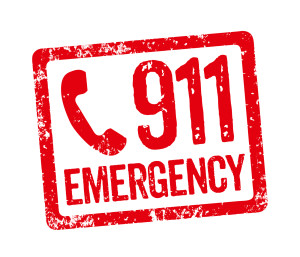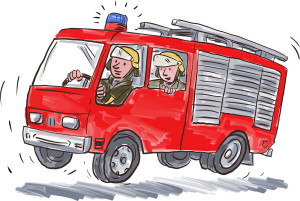Prepare Children To Act In An Emergency
I advocate for talking straight to children. They are little people afterall. A child is not a species unto itself. Sometimes people assert that a child is a child the way a cat is different from a dog.
A child is just a person who is growing and developing. They are going to be an adult. A cat will never become a dog. The development process is aided by providing information. AND it is just human nature to feel stronger and more capable when we feel prepared for the possibilities that could lie ahead.
So how do we prepare our children without scaring them? When are children ready for this preparation to begin?

Red Stamp on a white background – Emergency

Each child is different. You will know your child is ready to start learning emergency preparedness when they are able to talk to you about plans and remember those plans. If you can talk to your child about a mutliple step plan and they can remember it they are ready to start learning basic emergency reponse strategies. An example of such a plan: to have a play date that afternoon after lunch- that it will occur at the park and then you need to leave in time to make it to the post office and to pick up their brother. If they understand that plan and indicate a maintained understanding of the plan as the day progresses then you know that they can learn and practice an emergency plan.
Children see emergencies on cartoons and practice for them in school. They generally understand basic concepts of house fires, earthquakes etc. It is important to explain that the emergencies for which you are preparing them will most likely never occur.
Step 1: Consider where you live and what emergencies you may need to prepare them for. Where I live there is really no risk of a hurricane, but earthquakes are a big deal. If you live in an urban area where gang activity is present anywhere in the vicinity consider preparing them for drive by shootings. Think about what they need to know, if you are not right next to them, at the moment and you want them to be able to react in an instant.
Step 2: Do your research on the sorts of natural disasters that occur in your area and the strategies you are advised to employ. There may be contradictory theories out there. You need to have a firm preference in place as you present it to a child who still has concrete thinking and a need to have the reassurance of solid answers.
Step 3: Consider your resources. What neighbors do you trust? What are your escape points and routes? Do you have a home phone? Do you have an alarm panel? Do your children know how to use your cell phone? You want to have already worked out what your action plans are before you start talking to the child. It will come across as much more reassuring.
Step 4: Make sure your plans are adequate. That may sound silly, but it will not be very reassuring to a child if they start asking questions like how will I call for help? and you can’t provide a solid answer.
Step 5: Decide which topic to start with. Cover one during your first conversation. Try to keep the conversation brief and matter of fact. Kids tend to respond well to an approach along the lines of “Since you are such a big girl now it is time you know what to do to help yourself and all of us if there is a _____.
Step 6: In subsequent conversations cover new topics, but review the previously discussed plans at the beginning. Continuously material every few months there after

Illustration of a red fire truck engine firefighting apparatus with fireman fire fighter emergency worker riding on isolated white background.
Fire
Discuss house evacuation strategies from various points in the house. Give examples such as what you would like them to do if they are in the kitchen when a fire starts versus if they are asleep in bed when a fire starts.
Set a meeting point outside of the house where the family will reunite. Clarify under what circumstances you want them to directly leave the house versus joining you so you can leave together or assist them.
Decribe stop, drop, and roll. Practice it. Explain that it works by smothering flames that would be fanned by running.
Explain that smoke rises, and that getting low to the ground is very important to ensure they get enough oxygen as they get out.
Describe how the child should test a door knob for heat before opening a door to move towards an exit.
Describe how a child would utilize something like a bat or chair to break a window that would not open or to push out a screen. Tell them that would be okay.
Discuss where the call for help would be made. Perhaps on your cell phone if you have it, or which neighbors homes to go to.
Have emergency evacuation ladders at both end of any second story homes. Show the child where they are and demonstrate their use.
Once children are old enough to handle a fire extinguisher show them where they are located around the home. Show them how they function demonstrating the need to point the extinguisher at the base of the fire and make a sweeping motion.
* We like to have one near each source of heat and each major electrical appliance. Kitchen, laundry room, fireplace, garage…
Do a walk through to practice what you have reviewed with them. One time like they are asleep at the time, and the next time as though they were in the kitchen when the fire started.
ALL of this information may seem like it is too much to cover and is just scary. Children benefit from feeling like they are part of a plan, and that they are equipped with the knowledge that they need to feel secure.
* Over the top perhaps but I like the idea of having a large duffle bag tied to a rope under the bed when very young children are in the home. I mean babies through 2 years old. If they are too young to climb down a ladder out of a second story window I believe everyone can get out safer and faster if a child can be secured and quickly lowered down.

Man Hand writing Emergency Escape Plan with black marker on visual screen. Business, technology, internet concept.
Intruder
This one is harder to talk about without scaring children. It is important to explain that they are never at home without an adult, so the adult should handle the situation. Tell them what you want them to do.
I have told my children to flee the house the fastest way possible. This is going to vary by home. Again if there is a way to exit from the second story safely make sure they know to do that, rather than to approach any potential threat to use a primary exit.
Talk to children about what neighbors to approach and how to call 911.
If they cannot leave the residence discuss potential hiding places.
Mostly they need to know that it is expected that they will flee rapidly, without looking back, and call for help. They need to know that they should not approach the situation to check on any adult. If the adult in the residence can they will flee the house with them. If the adult in the house sounds afraid or hurt the child can help them best by leaving the residence to safety and calling for help.
Children need to know that this is most likely never going to happen. They also need to know what is expected if it does just in case. Explain that they will be safer and a bigger help if they flee the residence and get assistance. If an intruder were to enter my home I would never want my child to hesitate as to whether or not he should come check on me and waste valuable moments that could allow him to escape the situation and get help for us all.
Child Abduction/Child Predators:
This is discussed in another post due to its length and level of detail it is considered to be a separate discussion. To view the post click here.

Earthquake:
Earthquakes are not everywhere, but they are here. Substitute tornado or hurricane if need be.
This one is tricky only in that there are conflicting thoughts about where it is safest to ride out an earthquake.
Some believe in the triangle of life theory. Which is the idea that you position yourself where if the roof collapses a large piece of furniture is immediately next to you to absorb the impact. If the furniture collapses it’s mass should still allow for a pocket of space immediately next to it.
Traditionalists say sturdy doorways are the way to go.
I am not sure personally. I think that you have to consider the layout of your home, your furniture etc. Whatever you decide have some thought put into it. Have a plan that you feel most comfortable with and assert it to your children with clarity and confidence. This will allow them to feel prepared. Feeling prepared can allow for feeling secure and reduce moments of hesitation in an emergency situation.
What if they get lost:
In a store/business- ask an employee or approach a mother with young children. Give them your care giver’s name, and any phone number you have memorized if necessary. Explain what the employee will do, ie: take the child to a designated safe location and make an announcement over the speaker system or call the number provided.
In a public place such as a park, hiking trail anywhere there is not an employee available. Approach a mother with children. Explain the situation to her and give her contact information or a description and name of the caregiver you were separated from. If the caregiver is not quickly found with this person’s assistance then the police can be contacted if the child does not know the parent’s number.
* Why I do not like the advice to stay in one spot. If a child is lost they are likely to be crying. They will be feeling vulnerable and appearing vulnerable. It is my opinion (and remember I work with predatory people) that placing the child in the role of approaching an adult of their choice and giving them guidance as to who to consider is the better policy. If you let a child sit crying they will be approached eventually. This may be by a concerned mother, or it may be someone who sees an opportunity. So, unless they are sitting in an isolated place where they cannot get to other people then I do not feel like sitting in one place is the safest choice. I say approach an adult using sound informed judgment and get help.

And Now The Biggie!
You may wonder why to me this is the biggie. Why intruder is not the biggie. In many very disturbing ways, it can overlap with the intruder preparation. I do not recommend that overlap be discussed with the child.
For me the reason that this is the biggie is because it is the one where the child has absolutely no one but themselves to rely on. The heat is on and it is all on them!
What to do if your caregiver is unresponsive:
Unresponsive?! Huh…oh like a heart attack, stroke, a fall from a ladder you name it. Suddenly there is no care giver, and a very scary scene is unfolding in the home.
What does a child do after an effort to shake the adult doesn’t work?
Luckily this one is simple- but it is an emergency situation that often gets over looked by parents.
Show them how to call 911.
If you do not have a house phone then show them how to use your house alarm pad, or cell phone.
If that cell phone is unavailable, or they have made the call already, tell them to go to a neighbor.
Show them which neighbors to approach. explain why you are selecting those neighbors to make the choice more memorable.
To wrap it up explain that like all of these emergency situations it is unlikely to ever occur. Tell them that if they have called for help then they have done everything they could do. From there it is only important that they are safe, and have found an adult to assist them.
Finally–teach children their address and a parent phone number as soon as possible. With practice, children can learn these facts in preschool. It is knowledge they carry with them in their mind. They cannot lose it (as long as it is practiced regularly) and could be invaluable at some key moment. I have helped in my child’s first-grade classroom and have found that a surprisingly large percentage of children in first grade do not know their mom’s telephone number or their address.
Preparation goes a long way. It can leave the child feeling more empowered and confident. It can bring a parent peace of mind. Most importantly it can save lives.
Related Articles:
Stranger Danger: Talk Straight With Kids

Shannon
Latest posts by Shannon (see all)
- Social Anxiety: More Than Shy - July 10, 2016
- 3 BIG Reasons To Give Children Specific Meaningful Praise - June 27, 2016
- Protecting Children From Sexual Predators: Safety Without Paranoia - June 6, 2016


Leave a Reply